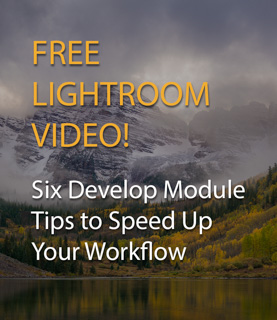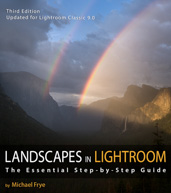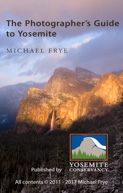In the Moment:
Michael Frye's Landscape Photography Blog
by Michael Frye | Jan 31, 2013 | Yosemite Photo Conditions
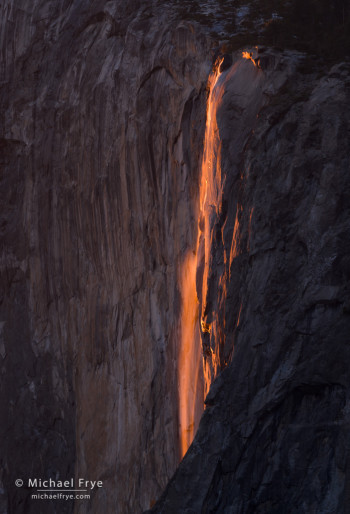
Low water, but ideal light on Horsetail Fall, February 20th, 2012
It’s almost February, so naturally I’ve been getting a lot of questions about Horsetail Fall. My thoughts about the best time to photograph Horsetail haven’t changed since I wrote this post last year: basically it’s February 16th to 23rd, or maybe a little beyond that.
This window was confirmed by my observations in 2012. There wasn’t much water in the fall last year, but we had a string of clear days, which allowed me to closely watch the light, and I think that February 16th to 23rd window is about right. You can, of course, take good photographs before or after that window; I’m talking about ideal light.
That ideal light requires clear skies to the west at sunset, something no one can predict at this point. And for good photographs the waterfall has to be flowing. Overall we’ve had a lot more rain and snow than last year, and Horsetail is flowing now. January, however, has been pretty dry, and there’s no precipitation in the forecast until at least next Wednesday. I think Horsetail will have more water this year than last, regardless of what happens over the next couple of weeks, but it would be nice to get some more snow on top of El Capitan soon to help feed Horsetail.
(more…)
by Michael Frye | Jan 13, 2013 | Announcements
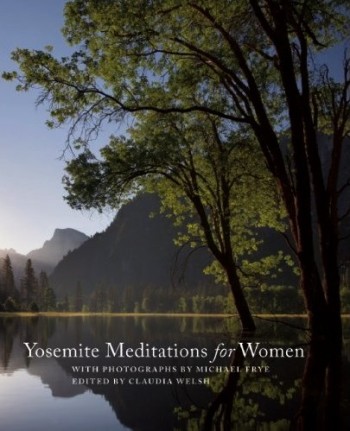
Yosemite Meditations for Women
My wife Claudia and I just got an advance copy of our new book, Yosemite Meditations for Women, published by Yosemite Conservancy. Claudia did a wonderful job of editing this — finding quotes, pairing them with photographs, and getting permissions from the authors. I’ll let you know when it’s available — it should be sometime next month!
— Michael Frye
by Michael Frye | Dec 31, 2012 | Announcements
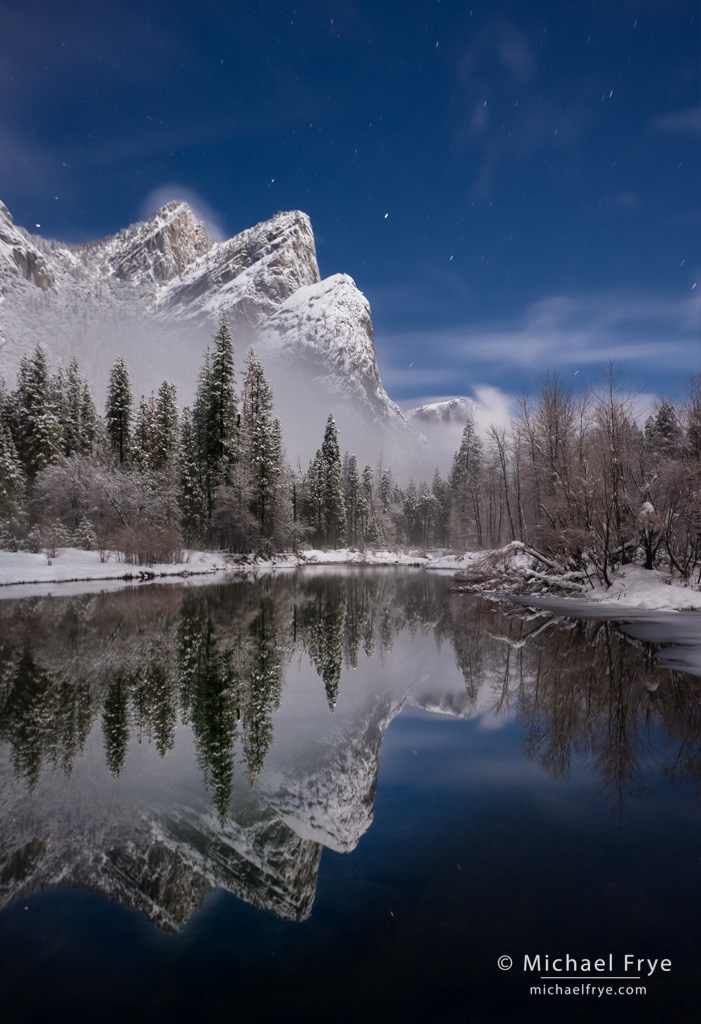
Three Brothers reflected in the Merced River on a moonlit night, Yosemite NP, CA, USA
It was 1985 — I think. My fiancé Claudia and I had started working at The Ansel Adams Gallery in Yosemite Valley in September. On New Year’s Eve it snowed, but after dark the storm broke, and a full moon appeared through rifts in the clouds.
Someone suggested going cross-country skiing in the moonlight. With a few co-workers from the gallery and other valley friends we gathered our ski equipment and headed out to the Ahwahnee Meadow. There were nine of us altogether (I only know that because a snapshot of the group has survived). Most of the group weren’t experienced skiers, and I remember a lot of flailing and falling while we were trying to cross a ditch in the meadow.
Then someone had the brilliant idea of skiing to Mirror Lake, about two miles away. In our youthful exuberance and folly we all thought this sounded great. We skied out past the Ahwahnee Hotel and along the old roads that lead to the lake. At one point Claudia, myself, and a few others got behind the rest of the group, only to be ambushed by snowballs as we entered a stand of trees.
We eventually made it to Mirror Lake around midnight. None of us thought to bring any champagne, but it didn’t matter — we were quite happy anyway, and thought it was a fitting way to greet the new year.
(more…)
by Michael Frye | Dec 13, 2012 | Composition, Critiques
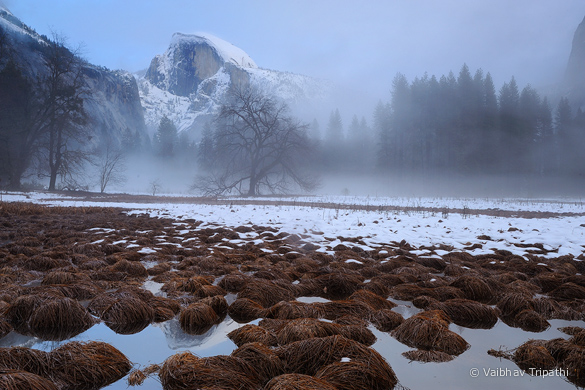
“Winter Mist Rising Beneath Half Dome,” by Vaibhav Tripathi
Here’s another long-awaited installment in my photo critique series. This time we’ll look at a photograph by Vaibhav Tripathi called “Winter Mist Rising Beneath Half Dome,” from my home territory, Yosemite National Park. It’s an interesting study in composition, and directing the viewer’s eye.
Light and Weather
The light is soft — no direct sunlight anywhere. Soft light is great for intimate scenes, but big, sweeping landscapes like this usually need sunlight to create contrast and keep the photograph from looking flat. Yet there’s actually a beautiful quality to the light here. This was made at dusk, and there’s a hint of alpenglow illuminating Half Dome, some blue in the sky, and of course the mist in the middle ground. The upper half of the photograph in particular has a luminous quality, and there’s a quiet, misty, mystical mood to the image. I also like the subtle hues and the warm-cool color contrast.
(more…)
by Michael Frye | Dec 4, 2012 | Yosemite Photo Conditions
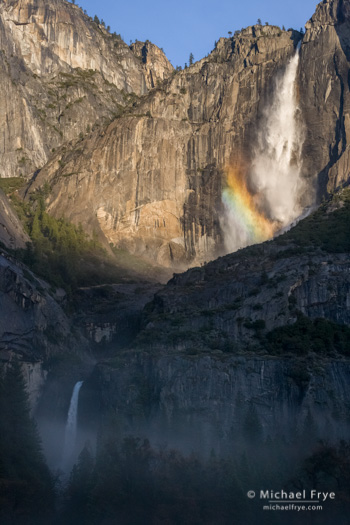
Upper and lower Yosemite Falls with a rainbow
For 20 years my wife Claudia and I lived in Yosemite Village, right underneath Yosemite Falls. In spring, when full from snowmelt, the roar from the fifth-highest waterfall in the world was the background music to our life in Yosemite Valley.
In late summer and autumn Yosemite Falls diminishes, sometimes dwindling to a wet stain on the cliff below Yosemite Point. This year it dried up even earlier than usual, a casualty of last winter’s meager snowfall.
But last week a series of warm, wet storms soaked northern California. Yosemite Valley received almost seven inches of rain between Wednesday morning and Sunday evening. Yesterday, after the storms finally departed, I drove up to Yosemite Valley, stepped out of my car at Swinging Bridge, and heard that familiar sound: the rumble of Yosemite Falls. It’s back, and so are all the other waterfalls in the Valley. It seemed more like May than December, except that the grasses were brown, and the trees were mostly bare with lingering splashes of fall color.
One of Yosemite’s photographic ironies is that in spring, when the thunder of Yosemite Falls rattles windows in Yosemite Village, the sun only hits the fall during the middle of the day. In winter the sun strikes the upper fall with beautiful, warm, low-angle light shortly after sunrise. You can even see rainbows from the right spot. But of course the flow is usually low during these colder months — except, that is, when heavy, warm rains fall, like they did last week.
(more…)






